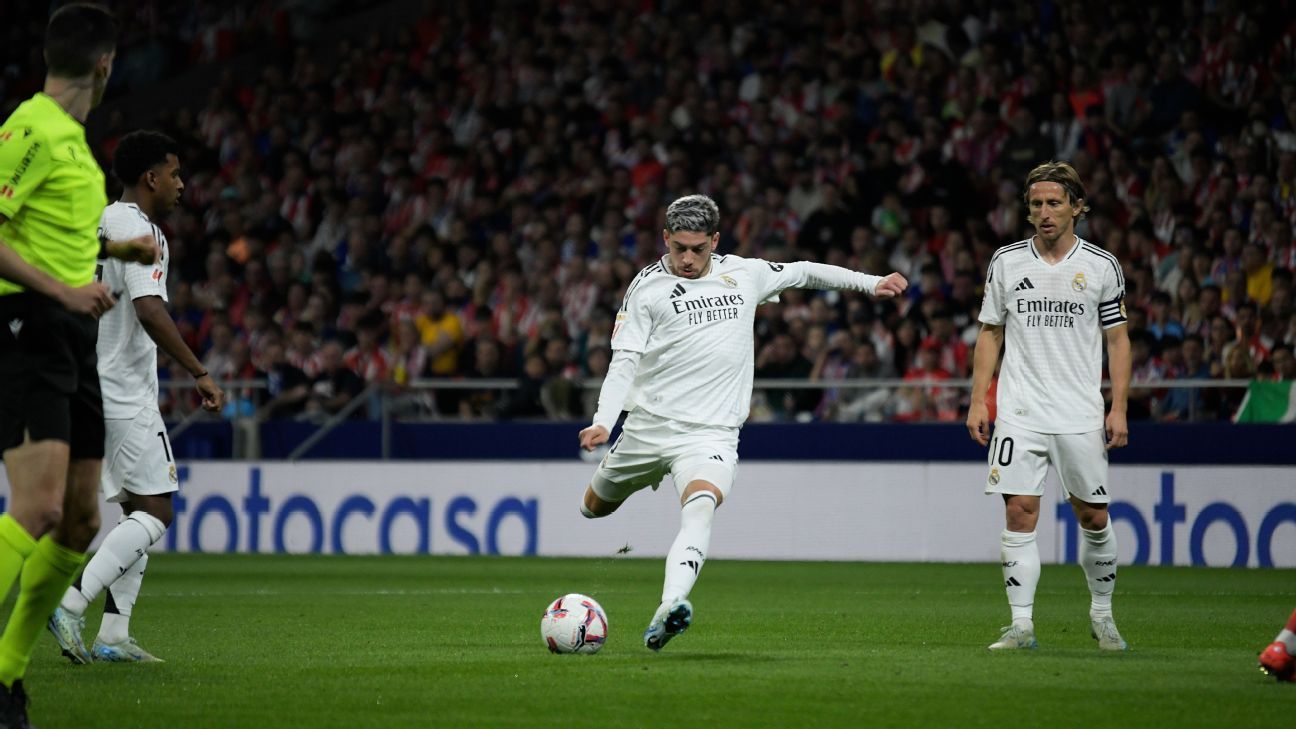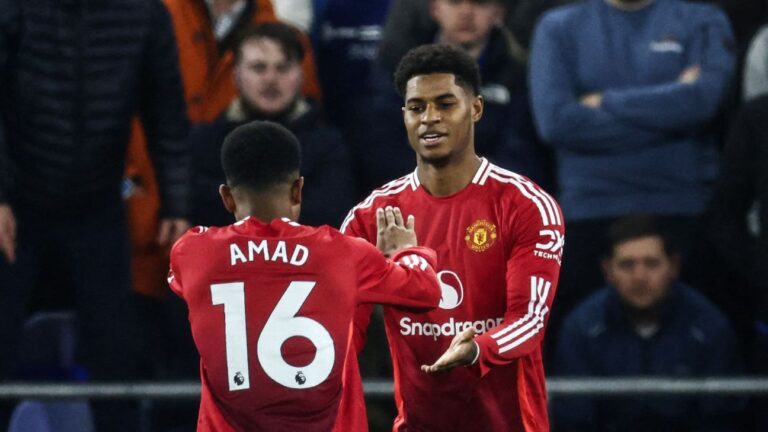-
Graham Hunter, Spain writerOct 15, 2024, 04:30 AM ET
- Graham Hunter is a Barcelona-based freelance writer for ESPN.com who specializes in La Liga and the Spanish national team.
For an art form that is allegedly dying out — if you believe the statisticians, anyway — goals scored from distance have played an important part in Spanish football recently.
Think of Rodri‘s rescuer for Spain against Georgia in their first Euro 2024 knockout game — and the huge outpouring of relief and joy when the Manchester City man struck home from 21 yards with his left foot. Or Lamine Yamal‘s spellbinding equaliser against France in the semifinal — the goal heard across the world. It was the goal of the tournament, curled past goalkeeper Mike Maignan from 26 yards out.
And before we leave the European champions, Martín Zubimendi‘s 21-yard volley meant three points against a stubborn, defensively organised Denmark at the weekend. It was the defensive midfielder’s debut goal for Spain and could prove vital if they’re to qualify for the chance to defend their reigning Nations League title.
Domestically, the story is just as strong. LaLiga was lit up by Luka Sucic mimicking one of Lionel Messi’s greatest goals (his was against Real Betis) but from far greater range, when he first-time volley-chipped over Jan Oblak from an absolutely outrageous distance in Real Sociedad‘s 1-1 draw against Atlético Madrid.
But the two pearlers from Real Madrid against Villarreal that same weekend catch my focus, as well as Los Blancos’ general attitude to shooting from distance while Carlo Ancelotti has been their coach.
Editor’s Picks
2 Related
The context is that those who produce big-picture stats tell us that both shooting from distance (here, I’m counting anything from outside the opposition penalty area) and scoring from that range are declining in regularity. “More passes, fewer shots” is the blunt, myopic summary. While it’s true that the generational move towards playing the ball out and using possession as a weapon have altered how eager many players (and coaches) are to listen to the primeval roar of “Shoooooooooooot!!” from their supporters, Madrid are one of the teams that definitely, and defiantly, buck that trend.
I’ll draw your attention back to the thunderbolt from Federico Valverde that put the Spanish and European champions in the lead at home to Villarreal on Matchday 9 of LaLiga. Jude Bellingham dummied Luka Modric‘s sharply taken corner before Valverde drew back, took aim and unleashed a shot in one gloriously smooth, but viciously dangerous, movement. It brought a breakthrough on the scoreboard, joyful veneration from the Bernabeu faithful, and face-contorted ecstasy from the Uruguay international.
The second, clinching, goal might be argued to be Vinícius Júnior‘s best for Madrid (although there are 92 beauties to choose from), but at any rate, it was thunderously glorious and unstoppable for goalkeeper Diego Conde.
Some of you will have forgotten that there was another example of the aim-steady-fire culture at Real Madrid when, in the first half not long after Valverde’s goal, Los Blancos recycled a Kylian Mbappé breakaway and the Uruguayan gave a lovely cushioned pass into Bellingham’s path for a driving effort from distance that went narrowly wide.
The context is this: Ancelotti views the business of setting up and scoring from long-distance shots as absolutely vital. Speaking personally, I don’t think I’ve ever reported on a squad that puts so much emphasis on the art.
Madrid’s reasons are twofold. Firstly, if your team is having a spell, either during a match or across a few games, struggling to break down banked defences, then shooting from distance introduces an element of threat and inventive chaos from which even deep-block defences can’t wholly protect themselves. Moreover, the space needed to see and unleash an excellent shot from outside the box is significantly less than the space and excellence of execution needed to string two, three, or perhaps four, one-touch passes around the box in order to open up a close-range scoring chance.
The second reason, certainly for Ancelotti and Madrid, is that while the calendar is as brutally hard as it’s been since early August for the champions of Spain and Europe, training unavoidably becomes a process of keeping the players ticking over with little time to teach, correct or demand almost anything physically.
Federico Valverde has proven a valuable contributor from long range strikes. (Photo by Juan Carlos Lucas/NurPhoto via Getty Images)
A few days ago, before the international break, I had the luxury of watching Girona train during one of their three-game weeks and the workout would have been something like 35 minutes. It was short, sharp and low impact, aimed at recuperating players’ energy levels and speed-of-reaction — but it was effective. Two days later, they beat Athletic Club in the 99th minute.
You can’t build a winning season wholly on 35- or even 45-minute sessions — but they are a necessity if you’re a Champions League side buckling under the physical and mental pressure of more games than you’ve ever faced before. Time management, energy management, extracting every single possible benefit you can from every minute — literally every minute — of contact with your players is now one of the greatest skills a coach can possess. Hence the reason that Barcelona coach Hansi Flick has an “activation training session” on the morning of every possible matchday. He uses matchday mornings to drum in tactical ideas, focus the mind, get players’ muscle memory awake — all designed to “steal” 35 or 45 minutes back out of an overcrowded working week during which all you want is to see your squad’s batteries recharging.
Ancelotti has, for large parts of his career, been the coach with the most demands on his coaching timetable. Whether at Juventus, AC Milan, Paris Saint-Germain, Chelsea, Bayern Munich or, most notably Real Madrid, time is always tight because demands and workloads are high. Things are tighter than ever right now for Los Blancos: they have a helter-skelter LaLiga timetable due to many days in January being lost to the Spanish Supercup staged in Saudi Arabia, and thanks to the introduction of a minimum of two extra matches in the UEFA Champions League qualifying stage.
Ancelotti has always valued the power of having several members of his team able to consistently hit the target from distance and the more that teams decide to block and thwart Madrid by sitting deep in numbers, the more the Italian has tried to ensure that the “joker” up his sleeve is an ability for Cristiano Ronaldo, Modric, Toni Kroos, Valverde, Vinícius, Karim Benzema, Sergio Ramos, or Bellingham to lash one in from long range.
But there’s a nuance to this, too. When Ancelotti’s training sessions are short and planned to avoid potential injury-inducing tackles or sprints (on those days which are purely for recuperation, not effort) then shooting drills are a great way to keep his players enjoying their work, competing with one another, improving a skill that will often win matches but avoiding anything approaching high-impact on already over-strained bodies and minds. It’s a great workout for the ‘keepers, too.
🧤️
🆕 INSIDE TRAINING 🆕#RMCity | #RMPlay— Real Madrid C.F. 🇬🇧🇺🇸 (@realmadriden) August 17, 2024
The players work at a wide range of drills: How to cut the ball back in the right way at the right time to the edge of the box; how to do that lovely, deft layoff (like a setter does for a spike in volleyball); how to be ready to snaffle up close-range rebounds off a keeper’s save — it goes on and on.
I watched one of them this season, and it was a joy to behold. Players look happy in their art, almost reverting to what they’d have been doing as kids, deeply competitive in the me-versus-the-keeper element, but also, given that it’s usually set up as a small game — competitive to try and be the guy who hits the net most often. Endrick and Arda Güler will be the newbies who most often do it and of the many things Madrid will miss in Dani Carvajal‘s injury absence, on the evidence of the training session I witnessed, his shooting ability will be one.
This specialty practice won’t pay off every week, and when Mbappé is firing on all cylinders the tactic might become less necessary as a ‘get out of jail’ card. But bet your bottom dollar that Ancelotti and Madrid will continue to try to buck the statistical trend of teams shooting and scoring from distance less often.
And bet any loose change you have on them pulling it off in regular, glorious fashion.







